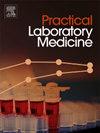Development of an accurate and sensitive assay for 2-methoxyestradiol using derivatization and liquid chromatography-tandem mass spectrometry
IF 1.7
Q3 MEDICAL LABORATORY TECHNOLOGY
引用次数: 0
Abstract
2-Methoxyestradiol (2ME) is involved in the pathogenesis of preeclampsia and antitumor activity. In addition to its low concentration in healthy human serum, presence of isomers makes quantification of 2ME for clinical research and laboratory medicine difficult. The objective of this study was to develop a highly sensitive and accurate method for quantifying 2ME using LC-MS/MS combined with derivatization with 1-(2,4-dinitro-5-fluorophenyl)-4,4-dimethylpiperazinium iodide (MPDNP-F). This approach significantly enhanced the detectability of 2ME in positive electrospray ionization-tandem mass spectrometry (ESI-MS/MS) and enabled the chromatographic separation of 2ME from isomeric metabolites possessing a methoxy group, including 4-methoxyestradiol, 3-O-methyl 2-hydroxyestradiol, and 3-O-methyl 4-hydroxyestradiol (3M4OH). Although the derivatized 2ME and 3M4OH were closely eluted under the optimized LC conditions, the different fragmentation patterns of these isomers during MS/MS allowed their distinction. The lower limit of quantification for 2ME was 2.5 pg/mL, indicating a satisfactory sensitivity. These findings demonstrated that this LC-MS/MS method combined with the MPDNP-F derivatization can provide accurate and highly sensitive quantification of 2ME.
求助全文
约1分钟内获得全文
求助全文
来源期刊

Practical Laboratory Medicine
Health Professions-Radiological and Ultrasound Technology
CiteScore
3.50
自引率
0.00%
发文量
40
审稿时长
7 weeks
期刊介绍:
Practical Laboratory Medicine is a high-quality, peer-reviewed, international open-access journal publishing original research, new methods and critical evaluations, case reports and short papers in the fields of clinical chemistry and laboratory medicine. The objective of the journal is to provide practical information of immediate relevance to workers in clinical laboratories. The primary scope of the journal covers clinical chemistry, hematology, molecular biology and genetics relevant to laboratory medicine, microbiology, immunology, therapeutic drug monitoring and toxicology, laboratory management and informatics. We welcome papers which describe critical evaluations of biomarkers and their role in the diagnosis and treatment of clinically significant disease, validation of commercial and in-house IVD methods, method comparisons, interference reports, the development of new reagents and reference materials, reference range studies and regulatory compliance reports. Manuscripts describing the development of new methods applicable to laboratory medicine (including point-of-care testing) are particularly encouraged, even if preliminary or small scale.
 求助内容:
求助内容: 应助结果提醒方式:
应助结果提醒方式:


